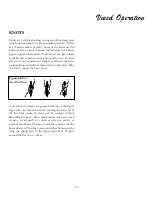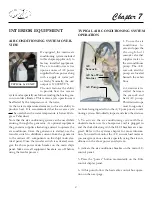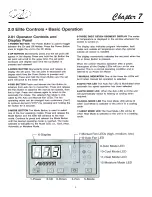
14
Chapter 6
EMERGENCIES
Always be ready to help others on the water if possible,
but do not take any unnecessary risks. Use equipment to
save a life, but do not risk a life to save equipment. Consult
earlier information in this manual concerning accidents,
etc. Also, read other literature concerning on the water
emergencies. Be alert and prepared!
FIRE
Fire aboard a vessel can spread quickly and can cause
tremendous alarm among everyone. Most fires can be
prevented by keeping the bilge free from oil and debris.
Keep all equipment stowed and maintained in working
order. Carry a backup fire extinguisher on board. If
something becomes a possible fire hazard, remove that
possibility at once.
Never use water on gasoline, oil or electrical fires. When
you dump water on an electrical fire a you can be shocked
since water conducts electricity.
Follow these instructions if a fire breaks out:
1. Fit everyone aboard with a life jacket. Turn off the
ignition.
2. Try to keep the fire downwind. If the fire is to the stern,
head the bow toward the wind. If forward, put the stern
to the wind.
3. If the engine should catch fire, shut off the fuel supply
Usually there is a fuel tank access that you can crimp the
fuel feed line.
4. Use a hand fire extinguisher. Make sure to point it at the
base of the flames. Use short bursts and sweep the
extinguisher side to side.
Remember: (A 4 pound
extinguisher discharges in 20 seconds)
These actions help prevent the fire from spreading to other
parts of the boat. You can extinguish fires quickly if you
act swiftly. Have a plan of action in motion in case a fire
breaks out.
FIRST AID
Knowing first aid can save lives. A first aid kit and the
ability to use it are important ingredients for the safety of
a skippers’ passengers, crew and vessel. Having confidence
and competence in handling medical emergencies on board
is a must for the skipper. Invest your time in a first aid
course available at the American Red Cross.
CPR (BASIC LIFE SUPPORT)
If someone is seriously injured have someone call for help
while the injured person is being attended.
Check for possible danger signs; loss of breathing,
unconsciousness, severe bleeding and heartbeat. If you
determine the individual is not breathing or unconscious
place the victim on their back on a hard surface and do
the following:
1. If unconscious, open the airway. Neck lift, head lift or
chin head lift.
2. If not breathing, begin artificial breathing. Pinch the
nose. Give 4 quick breaths. If airway is blocked, try back
blows, abdominal or chest thrusts and finger probe until
airway is open.
3. Check for pulse. Begin artificial circulation. Depress
sternum 2 inches. Fifteen compressions at a rate of 80
per minute. 2 quick breaths. Continue uninterrupted until
advanced medical support is available.
Summary of Contents for 30 EXPRESS
Page 1: ...30 EXPRESS OWNER S MANUAL...
Page 2: ...784022 OWNER S MANUAL 30 EXPRESS 12 2012...
Page 30: ...11 Safety On Board NAVIGATION LIGHT RULES...
Page 41: ...Chapter 2 22 Notes...
Page 44: ...3 Rules Of The Road NAVIGATION RULES...
Page 85: ...28 Chapter 5 Notes...
Page 105: ...4 Chapter 7...
Page 106: ...5 Equipment Operation...
Page 107: ...6 Chapter 7...
Page 108: ...7 Equipment Operation...
Page 109: ...8 Chapter 7...
Page 110: ...9 Equipment Operation...
Page 111: ...10 Chapter 7...
Page 117: ...16 Chapter 7...
Page 126: ...25 Equipment Operation ROTARY ENCODER AND MENU KEY...
Page 127: ...26 Chapter 7 USING THE ROTARY ENCODER AND MENU KEY...
Page 158: ...57 Equipment Operation BACKING A TRAILER 1 2 3 4 LAUNCHING RAMP...
Page 161: ...60 Chapter 7 Notes...
Page 195: ...34 Chapter 8 Notes...
Page 204: ...9 Troubleshooting TOILET SYSTEM DIAGNOSTIC CHART...
Page 209: ...14 Chapter 9...
Page 219: ...6 Chapter 11 Notes...
Page 221: ...2 Chapter 12...
Page 224: ...5 Technical Information 30 Express Deck Overview 30 Express Cabin Overview...
Page 225: ...Technical Information 12 6 30 EXPRESS...
Page 226: ...12 7 Technical Information 30 EXPRESS...
Page 227: ...Technical Information 12 8 30 EXPRESS...
Page 228: ...12 9 Technical Information 30 EXPRESS...
Page 229: ...Technical Information 12 10 30 EXPRESS 30 EXPRESS...
Page 230: ...12 11 Technical Information TYPICAL NEGATIVE GROUND SYSTEM...
Page 231: ...Technical Information 12 12 30 EXPRESS...
Page 232: ...12 13 Technical Information 30 EXPRESS...
















































